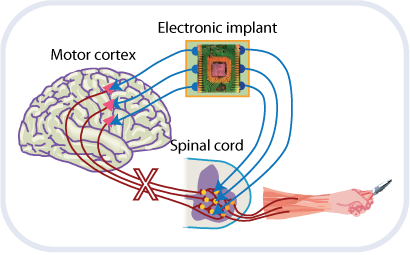Intraspinal Microstimulation to Restore Hand Function
In the UK, every year about 1,000 people suffer a spinal injury that leaves their hands, arms, and legs paralyzed. This condition is called tetraplegia. Most of these patients say that of all the functions they lost, hand control would be the one they want to regain above all. In this project, we develop a method to restore hand function for these patients.
In spinal injury, the information flow between the brain and the rest of the body is disrupted at some level in the spinal cord. Depending on the level of the trauma, different parts of the body will be affected: the higher the injury, the more control is lost. If the injury occurs in the neck (cervical) area, the hands will be affected.

What if we were able to bridge the injured bit of the spinal cord? Other research groups investigate stem cells, which could be placed in the spinal cord and regrow nerve fibres to bridge the damaged area. At the moment is not clear, however, if stem cells can be made to make the right connections, so other approaches are worth being investigated.
Whenever a person plans to perform a movement, cells in those parts of the brain that control hand and arm function – scientists call these areas motor and premotor cortex – become active (they “fire”). We implant tiny electrodes permanently in these areas, thus we know when a person wants to perform a movement and what kind of movement that is. The signals we record can then be processed in a little box just like a cardiac pacemaker. By feeding the processed signals back into the spinal cord below the injury, we can directly activate the cells (“motoneurones”) that control the muscles in hands and arms. Using many electrodes in the brain and in the spinal cord, patients should be able to control many different movements.
Not only will patients benefit directly from our research, but also we will gain knowledge about how the motor system processes signals in the spinal cord. Since many patients do not suffer a complete separation of the spinal cord, we assume that the use of our technique will strengthen the remaining connections, thus enabling patients to gain more control without having to use the implant.
Currently, we have to rely on animal models for our research, as it is at an early stage. Later, if our methods have been shown to work reliably, we will move on to clinical tests with patients. All our experiments have been approved by Newcastle University's ethics committee. We are very concerned about the wellbeing of our animals, and we constantly try to minimise the number of animals needed by refining our research techniques and using computer simulations whenever possible.
People involved in this project
- Jonas Zimmermann (PhD student)
- Dr Andrew Jackson (PhD supervisor)
- Prof Stuart Baker (PhD co-supervisor)
Posters
- Zimmermann, Jonas, Stuart N. Baker and Andrew Jackson (2009). “Functional upper limb movements generated by cervical intraspinal microstimulation in the monkey”. In: 39th Society for Neuroscience Annual Meeting 2009. 370.22/EE40. Society for Neuroscience. Chicago, IL.
- Jackson, Andrew et al. (2008). “Motor networks in the primate cervical spinal cord explored using intraspinal microstimulation”. In: 38th Society for Neuroscience Annual Meeting 2008. 860.19/JJ10. Society for Neuroscience. Washington, DC.
Sponsors of this study
Back to the Projects


